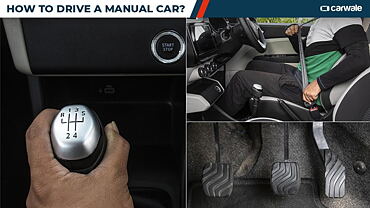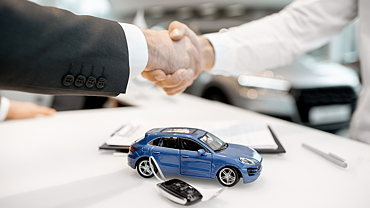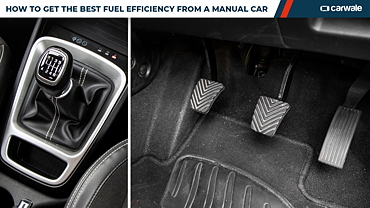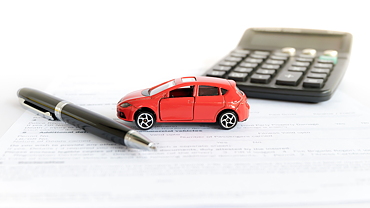
India has predominantly been a manual-car market, but with the influx of automatic transmissions, the 'art of driving a manual car' might be in jeopardy. Nonetheless, owning and driving a manual car is still a dream for many. However, it’s one thing to drive a car and another one to learn the art. So, here's CarWale’s comprehensive guide to driving a manual transmission car.

Before going any further, it's of utmost importance to understand the different pedals and levers involved in driving a car. To put it simply, driving a manual or a stick-shift car involves the A, B, C (accelerator, brake and clutch) pedals and a gear lever. The rightmost pedal is the accelerator and left-most is the clutch pedal. The one in the middle is the brake pedal, while the gear-shift lever is usually placed on the centre console and sometimes on the dashboard.
Accelerator – The A pedal is used to accelerate or get the car moving from a standstill and maintain momentum. Needless to say, more the throttle input, quicker is the acceleration.
Brake – As the name suggests, the brake pedal is used to decelerate or bring the car to a stop. Again, the more force you apply, the harder is the braking.
Clutch – The clutch pedal is one of the most crucial of the three, as it is used to slot into gear and set the vehicle in motion. The pedal is used to engage/disengage the clutch, which essentially transfers power from the engine to the wheels.

Before you start the car, ensure that you’ve adjusted the driver seat according to your preference, put the seatbelt on and engaged the emergency/parking brake. Next, you should familiarise yourself with the gearshift pattern (mentioned on the gear-lever) and try a mock gear-change to get a hang of it. Also, ensure that you are on a level field, so as to avoid rolling ahead or back. Then, follow the below-mentioned steps.
1. Adjust Your Mirrors – Once you familiarise yourself with the car, the first and foremost thing is to adjust the internal mirror and the wing mirrors according to your convenience. This ensures your safety as you wouldn’t have to fiddle with the mirror settings on the go or take your eyes off the road.

2. Start the car in neutral – After ensuring that the car is in neutral, crank the engine by turning on the ignition key and depressing the clutch pedal. Now, older cars may not require you to depress the clutch to switch-on the car, but most modern cars are designed in such a way that you need to engage the clutch before starting the engine. The practice also ensures that in case you forget to put the gearbox in neutral, the car still won’t give any hiccups while starting.
3. Shift into first gear – Now that the engine is running, you should engage the clutch completely with your left foot and shift the gear-lever into the first gear. And since we are on this point, remember that the left foot should only be used to operate the clutch, while the right foot has to be used to modulate the accelerator and brake pedals.

4. Setting the car in motion – To set the car in motion, disengage the parking brake while ensuring the clutch pedal is still depressed. Do not accelerate at this point. Now, start lifting the clutch pedal until you notice a drop in revs and the clutch plates start to come in contact. This is also called the ‘bite point’. At this point, disengaging the clutch further will make the car crawl ahead without any accelerator input.
If by mistake you stall the car, which you will a few times, turn off the ignition key and start all over again until you master this process. Once you get a hang of it, start applying subtle throttle inputs to make seamless progress. Also, ensure that once the car is in motion, release the clutch completely in order to not wear it out.

5. Upshifting into higher gears – With the car in motion, disengage the accelerator, engage the clutch and shift the gear-lever into second gear by following the shift pattern. Once you upshift, release the clutch and start applying moderate throttle inputs to maintain momentum. The usual upshift point is when the engine revs between 1,500-2,500rpm in petrol-powered cars and between 1,200rpm to 2,000rpm for diesel. Remember, the whole process of engaging/disengaging the clutch, upshifting, and modulating throttle inputs has to be synchronised in quick successions.

6. Downshifting to lower gears – In case you encounter a traffic jam and start slowing down, you’ll notice that the car starts shuddering. In such a scenario, you will have to downshift a few gears by following the same process of releasing the accelerator, depressing the clutch and downshifting to a lower gear (say, from third to second).
7. Stopping a manual car – In order to bring a manual car to a complete halt, downshift the gears gradually to the first gear by letting go of the accelerator and applying moderate force on the brake pedal. Once at crawling speeds, shift the car into neutral and allow it to freewheel without any throttle inputs, engage the clutch and depress the brake completely to bring the car to stops. On the contrary, in emergency situations, you can stop the car in any gear by depressing the clutch and shifting into neutral.

8. Reversing a manual car – Ensure you are at a complete stop before you shift into the reverse gear. And while reversing, make sure to take a look at your surroundings, especially ensuring there’s no vehicle or a person behind the car before you back up.
9. Parking a manual car – Unlike an automatic car, manual vehicles don’t have a ‘Park’ gear. Hence, it's important to engage the emergency/parking brake every time you park your car. Alternatively, you can also shift the car into the first or reverse gear to prevent it from rolling or moving.

10. Starting on an incline or driving downhill – One of the trickiest things to do is when you have to start on an incline, as there’s a risk of rolling back. In such a case, engage the parking brake, shift into first gear, start releasing the clutch and engaging the accelerator simultaneously, and once the car starts fighting against the parking brake, release it and throttle you way out. Timing is the key here.
On the contrary, while driving downhill, you must shift the car into a lower gear and let the engine do the braking, and let the car roll at lower engine speeds for better control. One must avoid shifting into neutral as it will result in considerable brake fade, and worse still a complete brake failure.

With all things said and done, it all comes down to practising the art of driving. Although you can practice alone with a valid driver’s license, it always better to have someone accompany you as you can learn the nuances of driving a manual car faster. It’s advisable to start off on an isolated field/parking lot and as you learn the tricks, move to less-crowded localities to master the skills.
Since manual transmissions are far simpler than automatics, they are easier to maintain as there is less chance of something going wrong. A manual gearbox also provides better control to the driver to extract more performance out of the car. What’s more, a stick-shift is more efficient than most automatic transmission cars. If that was not all, manual gearboxes are far cheaper than their automatic counterparts.

Dos
- Always check your surroundings for your and other’s safety.
- Familiarise yourself with the various functions and pedals/levers of the car.
- Wear a seatbelt at all times.
- Always start the car in neutral.
- Downshift while slowing down or in traffic.
- Always engage the emergency brake while parking the car.
- Use the hand brake while starting on the incline.
Don’ts
- Avoid engaging the clutch in traffic or at standstill.
- Do not shift into neutral while driving downhill.
- Avoid braking while you accelerate and vice versa.
- Do not shift into reverse while in motion.
- Avoid switching-on the car in any gear other than neutral.
- Refrain from engaging the clutch while accelerating in higher gears.

Now that you know all the steps involved in learning how to drive a manual car, don’t forget to enjoy driving it. And as always, follow all traffic guidelines, drive safely and respect fellow motorists.
Pictures by Kapil Angane





